
Garter snake is the common name for small to medium-sized snakes belonging to the genus Thamnophis in the family Colubridae. Native to North and Central America, species in the genus Thamnophis can be found in all of the lower 48 United States, and nearly all of the Canadian provinces south of the Northwest Territories and Nunavut—with the exception of Newfoundland and Labrador. They are found from the subarctic plains of west-central Canada east through Ontario and Quebec; from the Maritime Provinces and south to Florida, across the southern and central U.S. into the arid regions of the southwest and Mexico, Guatemala and south to the neotropics and Costa Rica.

The common garter snake is a species of snake in the subfamily Natricinae of the family Colubridae. The species is indigenous to North America and found widely across the continent. There are several recognized subspecies. Most common garter snakes have a pattern of yellow stripes on a black, brown or green background, and their average total length is about 55 cm (22 in), with a maximum total length of about 137 cm (54 in). The average body mass is 150 g (5.3 oz). The common garter snake is the state reptile of Massachusetts.

Rufus Wade Fox Jr., was an American zoologist and herpetologist from the University of California, Berkeley. He specialized in the anatomy of snakes and the systematics of the western garter snakes.
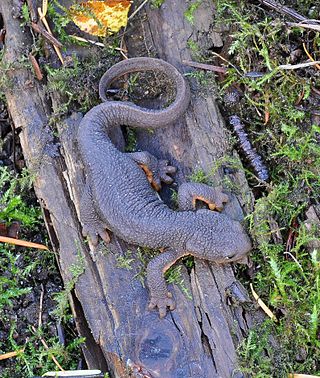
The rough-skinned newt or roughskin newt is a North American newt known for the strong toxin exuded from its skin.

Thamnophis saurita, also known as the eastern ribbon snake, common ribbon snake, or simply ribbon snake, is a common species of garter snake native to Eastern North America. It is a non-venomous species of snake in the subfamily Natricinae of the family Colubridae. The ribbon snake averages 16 to 35 inches in total length. It is dark brown with bright yellow stripes. The ribbon snake is not sexually dimorphic; however, females are normally thicker than their male counterparts.

The San Francisco garter snake is a slender multi-colored subspecies of the common garter snake. Designated as an endangered subspecies since the year 1967, it is endemic to San Mateo County and the extreme northern part of coastal Santa Cruz County in California.

The checkered garter snake is a species of garter snake in the subfamily Natricinae of the family Colubridae. The species is endemic to the southwestern United States, Mexico, and Central America.

The plains garter snake is a species of garter snake native to most of the central United States as far north as Canada and as far south as Texas. It has a distinctive orange or yellow stripe from its head to tail, and the rest of its body is mainly a gray-green color. The snake is commonly found living near water sources such as streams and ponds, but can also be found in urban areas and vacant lots. Although the IUCN lists the species as "Least Concern", some states have given it their own special status. This species is mildly venomous, although the venom is not toxic to humans.

The giant garter snake is the largest species of garter snake. Relatively rare, it is a semi-aquatic snake with a limited distribution in the wetlands of central California.

The Sierra newt is a newt found west of the Sierra Nevada, from Shasta county to Tulare County, in California, Western North America.
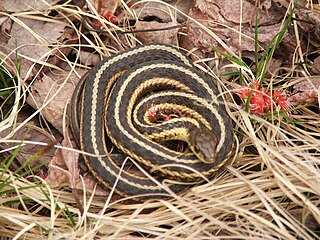
Butler's garter snake is a species of garter snake in the family Colubridae. The species is endemic to North America.

The western terrestrial garter snake is a western North American species of colubrid snake. At least five subspecies are recognized.
The narrow-headed garter snake, Thamnophis rufipunctatus, is a species of garter snake, endemic to the southwestern United States and adjacent northwestern Mexico. Its common names also include narrowhead garter snake and narrowhead watersnake.

Thamnophis cyrtopsis, the blackneck garter snake, is a species of garter snake of the genus Thamnophis. It is native to the southwestern United States, Mexico and Guatemala, and can be found in a wide range of different habitats, often near water sources.
Thamnophis sirtalis semifasciatus, the Chicago garter snake, is a subspecies of the common garter snake native to the Chicago, United States, region. It was described by Edward Drinker Cope in 1892, and can be found in the vicinity of rural waterways in northeastern Illinois, such as Piscasaw Creek in Boone County and McHenry County, Illinois.
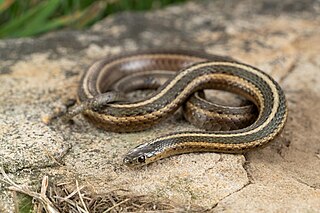
Thamnophis brachystoma, commonly known as the shorthead garter snake or short-headed gartersnake, is a small species of colubrid snake. The species is endemic to the north-eastern United States.

The California red-sided garter snake is a subspecies of the common garter snake. This slender subspecies of natricine snake is indigenous to North America and is one of three recognized subspecies of Thamnophis sirtalis found in California. While commonly confused with the subspecies T. s. concinnus, it is biologically part of the population of the subspecies T. s. tetrataenia, as pointed out by Boundy and Rossman (1995), but was preserved as T. s. infernalis as a neotype under ICZN code Article 75 in a 2000 decision by the International Commission on Zoological Nomenclature (ICZN) in 2000 in order to preserve the existing subspecies taxonomy.
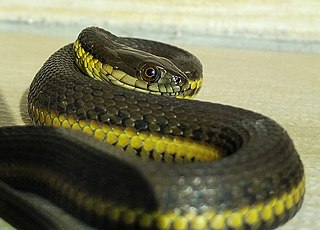
The blackbelly garter snake is a species of snake of the family Colubridae. It is found in Mexico.
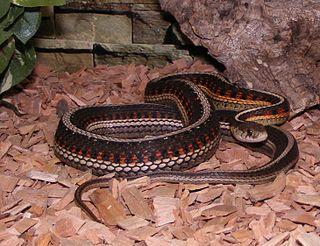
The red-sided garter snake is a subspecies of the common garter snake, in the subfamily Natricinae of the family Colubridae. This slender subspecies of natricine snake is indigenous to North America and is one of the recognized subspecies of Thamnophis sirtalis. This subspecies is widely spread across northern United States and southern Canada.


















